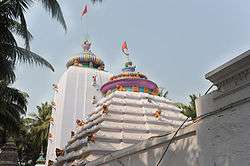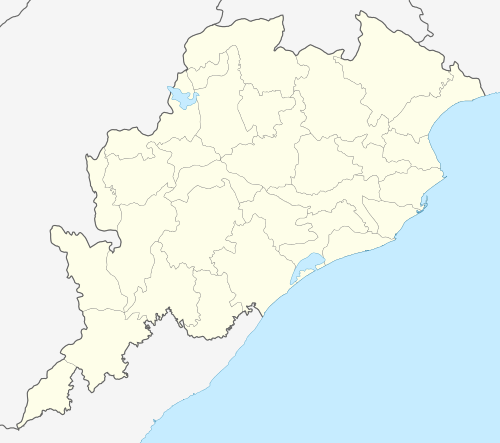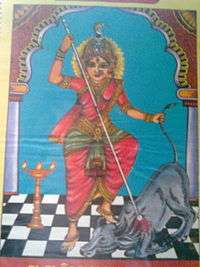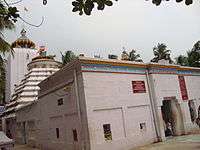Biraja Temple
| Biraja Temple | |
|---|---|
 | |
 Biraja Temple Odisha | |
| Geography | |
| Coordinates | 20°50′1.55″N 86°20′17.32″E / 20.8337639°N 86.3381444°ECoordinates: 20°50′1.55″N 86°20′17.32″E / 20.8337639°N 86.3381444°E |
| Country | India |
| State/province | Odisha |
| District | Jajpur |
The Biraja Temple, or Girija Kshetra (Oriya:ଓଡ୍ଡ୍ୟାଣ ପୀଠ), (Oriya:ବିରଜା ମନ୍ଦିର), is a historic Hindu temple located in Jajpur (about 125 kilometres (78 mi) north of Bhubaneswar), Odisha, India. The present temple was built during the 13th century. The principal idol is Devi Durga, who is worshiped as Viraja (Girija), and the temple gave Jajpur the nicknames "Viraja Kshetra" and "Biraja Peetha". The Durga idol has two hands (dwibhuja), spearing the chest of Mahishasura with one hand and pulling his tail with the other. One of her feet is on a lion, and the other is on Mahishasura's chest. Mahishasura is depicted as a water buffalo. The idol's crown features Ganesha, a crescent moon and a lingam. The temple covers a large area, and has several shrines to Shiva and other deities. According to the Skanda Purana it cleanses pilgrims, and it is called the Viraja or the Biraja kshetra. Jajpur is believed to have about one crore of Shiva lingams.
In Tantra


The Brahmayamala Tantra has a hymn, "Aadya Stotra", dedicated to Shakti. In the hymn, Vimala is the goddess of Puri and Viraja (Girija) is the goddess worshipped in the Utkala Kingdom, which became Odisha.
According to the Tantra Chudamani, Sati's navel fell in the Utkala Kingdom, also known as "Viraja kshetra". Adi Shankara, in his Ashtadasha Shakti Peetha Stuti describes the goddess as Girija. In Tantra literature, the Oddiyana Peetha (Devnagari:ओड़्याण पीठ) is located in eastern India near the Vaitarani River (an Oddiyana is an ornament worn by a woman around her navel).
Rituals and festivals
The primary ritual in the temple is Sharadiya Durga Puja, which begins on the night of Krishna Paksha Ashtami. This falls before Mahalaya, and ends on Ashwin Shukla Paksha Navami. The puja, known as Shodasha Dinatatmika Puja, lasts for 16 days. The ratha (chariot festival) is known as Simhadhwaja, and its flag bears a lion. During the lunar transition from Shukla Ashtami to Shukla Navami an animal sacrifice, Bali Daanam, is performed. Navratri is celebrated as Aparajita Puja.
Other festivals include Nakshatra, Shravana, Prathamastami, Pana Sankranti, Raja Parva and Navanna. Devi is worshiped daily in accordance with Tantra and Agama traditions as Mahishasuramardini by the Brahmins of Jajpur.
See also
References
- More About Temples Jajpur
- Trilochaneswar Temple of Jajpur
- Biraja Temple Official Website
- Pictures of Biraja Temple
- Report on Biraja Temple
- 51 Shakti peetha, Viraja among shakti peetha
